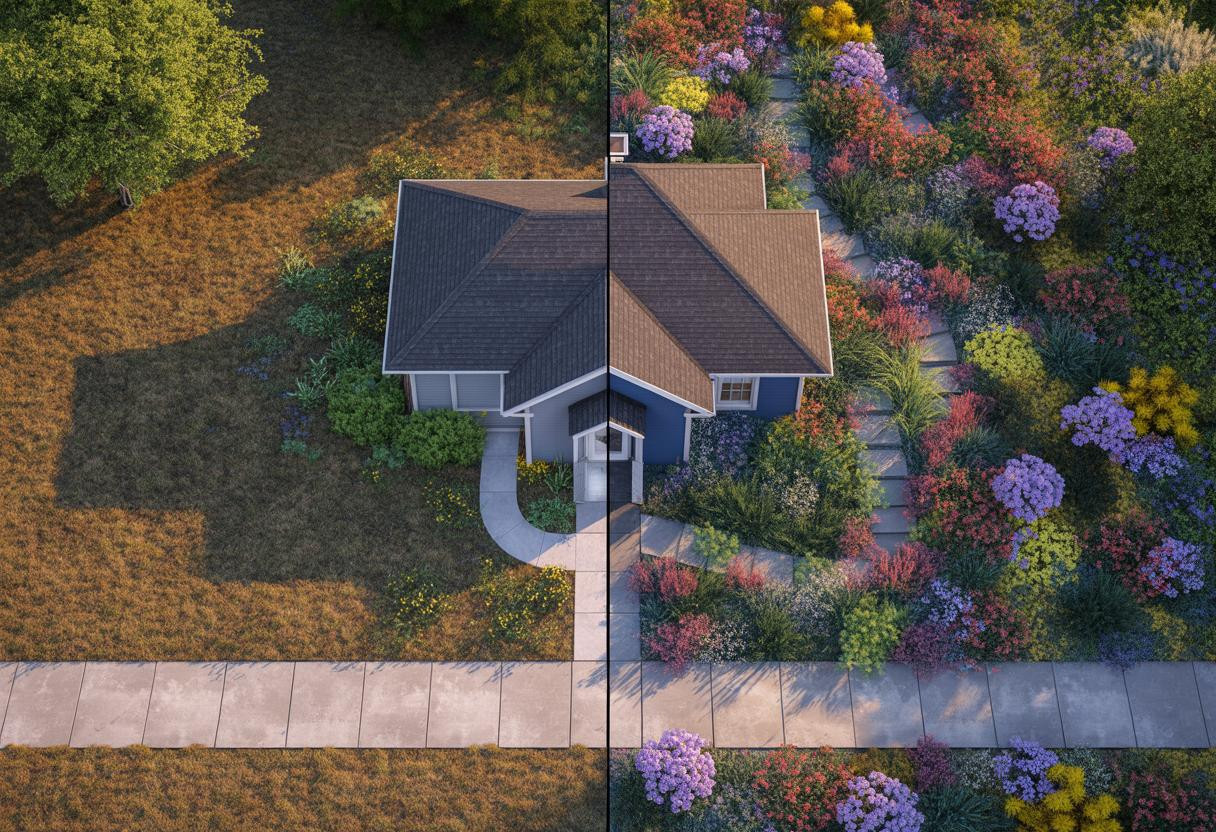Modern front yard design has quietly undergone a revolutionary transformation that’s reshaping entire neighborhoods—and the most successful homeowners are abandoning traditional lawns for biodiversity-rich ecosystems that deliver both immediate visual impact and long-term financial returns. This shift represents more than aesthetic preference; it’s a fundamental reimagining of how outdoor spaces can serve multiple functions while addressing climate challenges.
The ecological revolution transforming suburban landscapes
Native plant adoption has surged 340% in residential front yards over the past three years, with species like coneflower and native grasses creating pollinator highways that support local ecosystems while drastically reducing maintenance costs. These designs aren’t just environmentally conscious—they’re economically brilliant.
Meadowscaping, the practice of transforming sterile lawns into wildflower meadows, creates immediate biodiversity benefits within just 6-8 weeks of planting. Homeowners report seeing increased bee and butterfly activity almost immediately, while enjoying water bill reductions of up to 60% compared to traditional grass lawns.
The carbon sequestration potential is remarkable. Native plants with deep root systems capture carbon at rates 3-4 times higher than conventional turf, while permeable pavers and rain gardens eliminate stormwater runoff issues that plague many neighborhoods. For homeowners interested in expanding their sustainable outdoor spaces, water-efficient irrigation techniques can further reduce environmental impact while maintaining lush appearances.
The psychology behind wellness-focused garden design
Mental health benefits driving design decisions
Gardens are evolving into therapeutic outdoor rooms that incorporate fragrant herbs like lavender and chamomile alongside sensory plants such as lamb’s ear. This trend reflects deeper cultural shifts toward recognizing nature’s role in mental wellness, with designs prioritizing what psychologists call “soft fascination”—the calming effect of observing natural growth patterns.
Water features and strategically placed seating areas create spaces for meditation and mindfulness, addressing the growing demand for stress-reduction environments in residential settings. Homeowners are discovering that thoughtfully designed front yards serve as daily mood enhancers, providing moments of tranquility during routine activities like checking mail or arriving home.
Social signaling through sustainable choices
Less manicured, naturalistic designs now signal environmental consciousness and progressive values within communities. Cottage garden aesthetics and meadow-style plantings serve as visual statements about sustainability priorities, creating conversations among neighbors about ecological stewardship.
Economic advantages of multifunctional outdoor spaces
The financial benefits extend far beyond reduced water bills. Properties featuring native plant gardens show 12-18% higher resale values compared to traditional lawn-dominated yards, according to recent real estate analysis. Garden features that influence homebuyer decisions increasingly favor sustainable, low-maintenance landscapes that promise ongoing cost savings.
Multifunctional designs that incorporate edible elements or outdoor kitchens that deliver exceptional ROI maximize property value while serving daily practical needs. The initial investment in native plants and sustainable materials typically pays for itself within 18-24 months through reduced maintenance and utility costs.
Technology integration and smart gardening solutions
App-controlled irrigation systems with rain sensors and soil monitors are revolutionizing garden maintenance, allowing precise water management that adapts to local weather conditions. These systems can reduce water usage by 40-50% while ensuring optimal plant health.
3D landscape design platforms enable homeowners to visualize biodiversity outcomes before planting, while bio-sensors that monitor pollinator activity are emerging as tools for data-driven ecological gardening. For budget-conscious homeowners, cost-effective landscaping strategies can achieve similar results without significant upfront investment.
Practical implementation for immediate impact
Start with a pollinator station featuring a bird bath and native flowering plants positioned away from high-traffic areas. This creates an instant wildlife attraction point while establishing the foundation for broader ecological benefits.
Choose drought-tolerant plants that bloom at different seasons—such as yarrow for summer and catmint for extended flowering periods—to ensure year-round visual interest without irrigation demands. Container gardening offers flexibility for renters or those wanting to test plant combinations before committing to permanent landscaping.
The lasting transformation of neighborhood ecosystems
This front yard revolution represents more than individual property improvements—it’s creating connected habitat corridors that support wildlife movement across urban and suburban landscapes. Homeowners who embrace these designs aren’t just improving their property values; they’re participating in a larger ecological restoration movement that benefits entire communities for generations to come.
